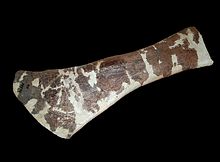Magyarosaurus
| Magyarosaurus | |
|---|---|

| |
| Humerus, Deva Natural History Museum | |
| Scientific classification | |
| Domain: | Eukaryota |
| Kingdom: | Animalia |
| Phylum: | Chordata |
| Clade: | Dinosauria |
| Clade: | Saurischia |
| Clade: | †Sauropodomorpha |
| Clade: | †Sauropoda |
| Clade: | †Macronaria |
| Clade: | †Titanosauria |
| Clade: | †Lithostrotia |
| Genus: | †Magyarosaurus von Huene, 1932 |
| Type species | |
| †Titanosaurus dacus | |
| Species | |
| |
| Synonyms[1] | |
| |
Magyarosaurus ("
Discovery

Remains belonging to at least ten individuals have been recovered from the Hunedoara region (Sânpetru Formation) in the area which was, at the time of their discovery, Hungary, but is now western Romania. Initially they were named Titanosaurus dacus, the specific name referring to the Dacians (who had lived in that place about 2000 years ago), by Baron Nopcsa in 1915.[3] Nopcsa had collected fossils in the area since 1895. The species was later renamed Magyarosaurus dacus by Friedrich von Huene in 1932.[4] von Huene in 1932 also named two other species: M. hungaricus and M. transsylvanicus. Larger, rarer M. hungaricus may represent a distinct taxon.[5]
The holotype, BMNH R.3861a, consists of a set of vertebrae. Numerous other bones have been found, mainly caudal vertebrae but also dorsals and elements of the appendicular skeleton. No remains of skulls are known. There has been a discovery of 14 fossil eggs which have been attributed to Magyarosaurus.[6]

Description

Magyarosaurus was a relatively small sauropod, reaching 6 m (20 ft) in length and 750–1,000 kg (1,650–2,200 lb) in body mass.[7][8] Its small size is a distinguishing autapomorphy, for none of its close relatives had such a reduced size.[5] Magyarosaurus is also notable for the presence of dermal armour.[9][10]
A distal caudal vertebrae was referred to the genus by Codrea et al. (2008). It was probably from near the middle of the tail as it has transitional features. Before it was definitively buried, the neural arch was broken off, probably by repositioning of the vertebrae from its original position. Its centrum is elongated, and measures 105 millimetres (4.1 in) long. Both sides that would have articulated with vertebrae were severely damaged. It is assigned to Magyarosaurus on the basis that no other sauropods are known from the region it was found in, and the fact that it is located between the two vertebrae compared with it because of its intermediate morphology.[1]
Paleobiology
Dwarfism
The islands it inhabited led to Magyarosaurus becoming a product of
Histology

In 2010, Koen Stein et al. studied the histology of Magyarosaurus. They found that even the smallest individuals appeared to be adults. They also retained "M." hungaricus to represent the larger specimens that were too big to be variations of the smaller specimens. The histology of Magyarosaurus showed that it had a very reduced growth rate, but even so, had a high metabolic rate.[5]
Armour
An osteoderm discovered in the "La Cãrare" locality. The locality is near Sînpetru village, in the
Possible eggs

Lithostrotian eggs have been assigned to Nemegtosauridae. The eggs possibly belong to either Magyarosaurus dacus or Paludititan, the former being more likely.[9] The Hațeg Basin was a large nesting place in the late Cretaceous, and is served as that for hadrosaurids, and titanosaurs. 11 eggs have been assigned to Nemegtosauridae, all from the Sânpetru Formation.[9] Embryos were preserved inside the eggs, and one egg shows proof of dermal armouring.[9]
The eggs were uncovered in 2001, during a field expedition by a Belgo-Romanian team. They were originally identified as in nests, but now it has been shown that no nesting structures has been preserved.[9]
Paleoecology
During the early Maastrichtian, the Hațeg Basin was subhumid, and had seasonal precipitation. However, during the later age of the formation, a large-scale paleoenvironmental change occurred, the region transformed into an extensive wetland.[12]
Magyarosaurus dacus is known from the early Maastrichtian of the Sânpetru Formation, part of the Hațeg Basin in Romania.
M. sp. is known from a vertebra. The vertebra was found in the latest Cretaceous of the
See also
References
- ^ a b c d Codrea, V.A.; Murzea-Jipa, C.; Venczel, M. (2008). "A Sauropod Vertebrae at Râpa Roşie (Alba District)" (PDF). Acta Palaeontologica Romaniae. 6: 43–48. Archived from the original (PDF) on 2016-03-03. Retrieved 2014-01-28.
- ^ ISBN 0-520-24623-3
- ^ Nopcsa, F (1915). "Die Dinosaurier der siebenburgischen Landesteile Ungarns". Ungar. Geol. Reichsanst. 23: 1–26.
- ^ von Huene, F. (1932). "Die fossile Reptil-Ordnung Saurischia, ihre Entwicklung und Geschichte." Mong. Geol. Pal., 4(1) pts. 1 and 2, viii +361 pp.
- ^ PMID 20435913.
- ^ "Briefing", Geology Today 7(1): p. 2-6.
- ^ Paul, G.S. (2010) The Princeton Field Guide to Dinosaurs, Princeton University Press p. 213
- PMID 24802911.
- ^ PMID 22412852.
- ^ a b c Csiki, Z. (1999). "New evidence of armoured titanosaurids in the Late Cretaceous - Magyarosaurus dacus from the Hateg Basin (Romania)". Oryctos. 2: 93–99.
- ^ ISBN 978-1-77085-049-1.
- ^ .
- .
- ^ ISBN 978-1-4214-0027-3.
- ^ PMID 23382886.
